Calisthenic Exercises
Description
This section is from the book "The Corner Cupboard; Or, Facts For Everybody", by Robert Kemp Philp. Also available from Amazon: The Corner Cupboard; or Facts for Everybody.
Calisthenic Exercises
Calisthenic Exercises. Use of Calisthenics. It is an admitted physiological fact, that imperfections in the female form originate, for the most part, in defective or irregular muscular action. The calisthenic exercises are calculated to cure deformities of the figure, especially of the chest, to invigorate the system, and. conduce to elegant deportment and symmetry of form.
Preliminary Cautions. 1st, that they should not be performed after a full meal; 2nd, that there should not be any ligatures or tight strings, straps, etc., on any part of the body, but that the clothes should fit easily and loosely; 3rd, that the body should not be too warmly clothed during the exercises, but that an additional wrapper should be provided, to cover the body as soon as they are finished; by this means cold will be avoided ; 4th, that the exercises should generally be performed in a room, in preference to the open air; 5th, that due regard must be paid to the health, age, and strength of the pupils exercised.
Necessary Apparatus. The first things to he attended to are the cautions we have given above; and then the necessary apparatus, consisting of dumb-beils, back-board, clubs, wands or poles, triangles, and elastic-cord, must be procured.
The Dumb-Bells we advise are constructed as follows. To the staff a (which is made of oak or ash, six inches long, and one and a quarter inches in diameter), is fixed a hemisphere (b), with a male screw (e); and to this part is attached at both ends another hemisphere (c), fitted with a female screw, so that when these hemispheres are screwed together they form a complete sphere as represented by d, in fig. 1.
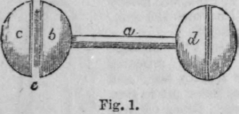
Back-Boards should be fitted to the person requiring them, unless they are used for the hack-board exercise, in which case they will be as represented in fig. 2. When not used for this exercise, they are fastened to the back and shoulders by means of straps (a b, c d,) which pass round the shoulders and are made to buckle in front. These straps can be lengthened or shortened by passing them through holes in the board (g,g,g,g,) left for that purpose. The lower part of the board is fastened round the waist by a strap (e f), which buckles in front.
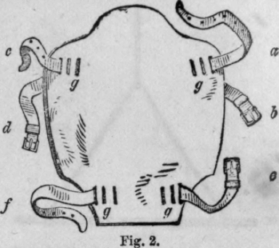
The dimensions of the short back-board are as follow, for a barge size: length twelve or thirteen inches, breadth ten inches, lower part five inches, and upper part four inches. These measurements can be reduced according to circumstances, age, etc.
The Long Back-Board should be broad in the centre, as in fig. 3, so that the flat part may reach across the back of the shoulders, and the handles (a b) be long enough to hold in the hands when the arms are extended. Some of these back-hoards vary from six feet in length to only three feet eight inches.

The Clubs for calisthenics should be made hollow, as in the annexed figure (fig.4) varying from twenty to twenty-eight inches in length, and be of a proportionate width. The top is made to screw on, so that the inside may be loaded as recommended for the dumb-bells. By this means, the weight to be forced through the air can be proportioned to the strength or ower of the individual to propel it.
The Wands, or Poles, should be light, smooth, and sufficiently thick not to bend. They vary in length according to the person's height that is to use them, the rule being, that the poles shall be of the same length as the height of the person requiring them.

The Triangle is a bar of wood attached to a cord at each end; the two cords meet above, as shown in fig. 5, so as to form two sides of a triangle, of which the bar forms the third. A cord is attached to the upper part of the triangle, and this, passing over a pulley, enables the teacher to lower or raise the bar so as to suit the height of the pupil. The Elastic Cord is one of the latest improvements in calisthenie exercises.

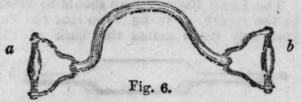
It consists of two handles (a b), of a triangular form, to which is attached an elastic cord, made of vulcanized india-rubber. They may be obtained at most toy-shops, and vary in price from two to five shillings, according to the size.
The pupil should commence the exercises with the dumb-bell practice.
The Dumb-Bell Practice. The dumbbells are not to be used at first; but when the pupil has become proficient in the following exercises, then the dumb-bells are to be held firmly in the hands, which are to perform the same motions directed below.
Position of Attention. When the word attention is given by the teacher, the pupil is to draw back the shoulders, so as to make them square ; the heels arc, to be placed in a line, and closed; the knees straight, the toes turned out an angle of 60 degrees, the arms hanging close to the body, the elbows turned in close to the side, the hands open to the front, the little finger lightly touching the dress, and the thumb close to the forefinger. The abdomen is to be slightly drawn in, and the chest advanced, but without constraint; the body upright, inclining a little forward, so that the weight of it may be principally on the fore-part of the feet; the head erect, and the eyes looking straight to the front, as in fig. 7.
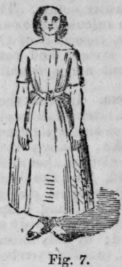

First Practice. One. - At the word one, raise the hands and bring the tips of the fingers in a line with, and pointing towards the shoulders, the body inclining forward, the head erect, and shoulders kept well back, with the elbows close to the side, as in fig. 8.
Two. - Dart the hands straight to the front, with straight arms, the palms of the hands close together, the thumbs close to the fore-finger, nearly in a line with the chin, as in fig. 9.
These two motions are to be repeated from two to one, and again from one to two, several times before commencing three.
Three. - The hands are thrown back with straight arms in a line with the shoulders the palms of the hands to the front, the thumbs close to the fore-fingers, the head erect, and shoulders kept well back, the body inclining forward, the heels raised off the ground, so that the weight of the body rests on the fore-part of the feet, as in fig. 10.
These motions are to be repeated from three to two, and from two to three several times before commencing four.
Four. - The arms are to be brought gradually by the side to the first position, (fig.
Second Practice. One. - The hands are to be brought smartly up with the palms of the hands to the front, the tips of the fingers in a line with the shoulder, pointing upwards, the elbows to be kept close to the side and well back, so as to square the shoulders; the head is to be held erect, and the body slightly inclined forward, as in
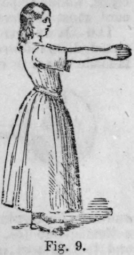
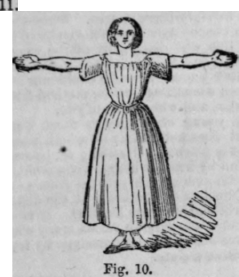
Two. - Raise the elbows a little so as to draw them upwards and backwards; then bring the hands smartly down to the side, as in fig. 12, and assume the position of attention (fig. 7),


Long Back-Board Exercises. The long back-boards (fig. 3.), are to be held by the handle with the left hand, and the right hand is to be placed on the top of the back-board, while the other end rests upon the ground between the feet, as in fig. 13.
Attention. When this word is given the heels are to be brought in a line, and the back-board brought across in front of the thighs at the full extent of the arms, holding it by the handles with both hands (the backs of the hands to the front), as in fig. 14
One. - The back-board is to be gradually raised from the position of attention, with the arms straight, until the flat part of it is horizontal and over the head, the tips of the fingers in front, and the knuckles behind; the body is to be kept well forward on the fore-part of the feet, and the head erect, as will be seen in fig. 15.
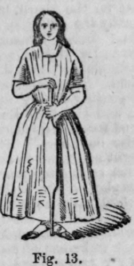
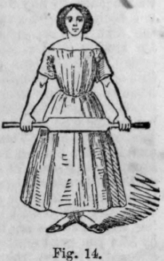
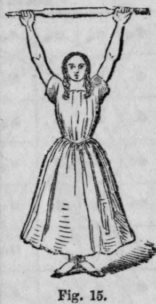
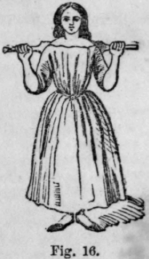
Two. - At this word the back-board is to be lowered from position one (the arms being contracted), and it is to be brought across the back part of the shoulders (as in fig. 16), still keeping the body well forward, and the head erect.
In the last position, the pupil will then be required to walk slowly round the room, quickly, and to practise the balance-step without gaining ground.
When the various exercises have been frequently repeated, the word "steady" will be given, when the position of attention (fig. 14) is to be resumed, and at the command "stand at ease," that position (fig. 13), with the back-board, is at once to be taken.
Continue to:


